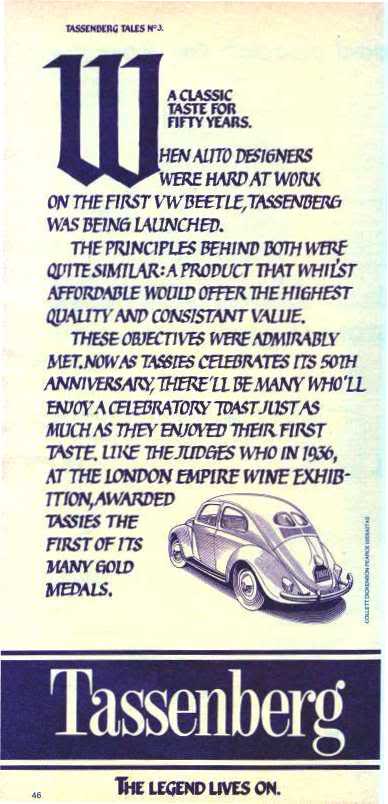Tassenberg vs Beetle
Posted: Sun Nov 23, 2008 7:39 pm
Ad from 1986 - I think I've had more Tassenberg through my system than many people - but that was a long time ago 


Forum for Aircooled VW enthusiasts
https://www.aircooledvwsa.co.za/

The brand's biggest crisis came in 1998 when careful examination of the label revealed the contents had become a product of SA and Argentina. In an avalanche of alliteration, Melvyn Minnaar, writing in the Mail & Guardian, reported that "tradition has been trashed… not only in Matieland, Melville and Malmesbury, but also in Mozambique".
It was a "terrible Tassenberg tragedy" with nary a dry barfly eye between Troyeville and Touwsrivier. Le Roux recalls that: "There was a shortage of South African red at that time and we were offered well-priced non-varietal red from Argentina. It never made up much of the blend in terms of volume".
The last of the South American red was used up in 2003 and, since 2004, volumes have imitated a rocket. Bucholz notes: "You could taste that foreign character in the wine and it wasn't popular. Since we've become a 100% South African product [again], volumes have taken off." Tassenberg is a popular tipple in Namibia, Mozambique and Angola "where it is drunk neat or as a Catembe, mixed with Coke". As Le Roux comments: "The Portuguese tradition of adding Coke to red wine continues in our neighbours to the north and I'd guess they drink about 20% of our production".
With some unlikely high profile consumers, like the late Angolan rebel leader Jonas Savimbi, whose widow Lisa Jaime promises to transfer 30% of his $25 million fortune into my bank account once I gave her my pin code it remains the biggest selling South African red. And perhaps because of that, is unlikely to shoot out any lights at a wine show or blind tasting. Heck, it didn't even get a listing in WINE's 2007 Best Value Wine Guide or qualify for its own website like other upstream Distell brands Zonnebloem and Fleur du Cap.
But Bucholz calls the current bottling "very surprising. Do yourself a favour and taste it blind against competition like Namaqua and even some estate wines. It is very definite value for money". An observation confirmed by Le Roux who notes that the current red wine glut has given a much better choice of blending material.
Bucholz recalls a recent market survey in Namibia that concluded it was so surprising to see a product do so well when it was so misrepresented. "What does the strap-line 'the legend lives on' mean to an Ovambo?" he asks. "We used to simply export our local marketing campaign to places where it means zilch. But we're having another look at that now."
The first edition of John Platter's SA wine guide (1980), published back in the days when John used to taste all the wines, Tassenberg scored 2 Stars (translation: good) and was called a "lightbodied dry red vin ordinaire with a tremendous following. A no-nonsense easily swigged-down Pinotage-Cinsaut-based blend that did much to change the tastes of the public from sweet to drier wines. If kept, it ages remarkably well".